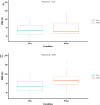The effects of eccentric cycling on vascular reactivity
- PMID: 40177355
- PMCID: PMC11961952
- DOI: 10.3389/fphys.2025.1554054
The effects of eccentric cycling on vascular reactivity
Abstract
Purpose: Eccentric cycling has gained attention as a novel exercise modality that increases muscle performance at lower metabolic demand, which could enhance cardiovascular rehabilitation. However, endothelial function response to eccentric cycling (ECC) has yielded contradictory results. Therefore, the purpose of this study was to determine the effect of 30 min of moderate-intensity cycling ECC on endothelial function.
Methods: A total of 15 (9 females, 6 males) young, apparently healthy participants were recruited for two laboratory visits. First, a maximum oxygen consumption (VO2max) and blood lactate (BLa) threshold were measured to determine moderate workload intensity, followed by a familiarization stage on an ECC ergometer. During the second visit, a 30-min of moderate ECC was performed 72 h after the first visit. Endothelial function was measured via Flow-Mediated Dilation (FMD) pre- and post-exercise bout. FMD was calculated following traditional recommendations and adjusting for exercise-induced endothelial shear stress (ESS), utilizing the same pre-exercise baseline artery diameter for post-exercise FMD calculations.
Results: There was a significant increase in endothelial function (p = 0.037) when adjusting pre-exercise baseline diameter to adjust for ESS, but when utilizing the traditional method no change in endothelial function was observed.
Conclusion: 30-min of moderate ECC showed a significant improvement in endothelial function when accounting for exercise-induced ESS. These results support the use of the pre-exercise baseline diameter when calculating post-exercise FMD to avoid the exercise-induced ESS or muscle metabolites effects on post-exercise artery diameter.
Keywords: eccentric cycling; endothelial function; endothelial shear stress; exercise-induced; flow-mediated dilation.
Copyright © 2025 Gomez, Montalvo, Conde, Ibarra-Mejia and Gurovich.
Conflict of interest statement
The authors declare that the research was conducted in the absence of any commercial or financial relationships that could be construed as a potential conflict of interest.
Figures



Similar articles
-
Effects of Different Eccentric Cycling Intensities on Brachial Artery Endothelial Shear Stress and Blood Flow Patterns.Res Q Exerc Sport. 2025 Jun;96(2):287-297. doi: 10.1080/02701367.2024.2404139. Epub 2024 Sep 20. Res Q Exerc Sport. 2025. PMID: 39302246
-
Acute impact of conventional and eccentric cycling on platelet and vascular function in patients with chronic heart failure.J Appl Physiol (1985). 2017 Jun 1;122(6):1418-1424. doi: 10.1152/japplphysiol.01057.2016. Epub 2017 Mar 16. J Appl Physiol (1985). 2017. PMID: 28302709
-
Divergent endothelial function but similar platelet microvesicle responses following eccentric and concentric cycling at a similar aerobic power output.J Appl Physiol (1985). 2017 Apr 1;122(4):1031-1039. doi: 10.1152/japplphysiol.00602.2016. Epub 2017 Feb 2. J Appl Physiol (1985). 2017. PMID: 28153942
-
Physiological response to eccentric and concentric cycling in patients with chronic obstructive pulmonary disease.Appl Physiol Nutr Metab. 2020 Nov;45(11):1232-1237. doi: 10.1139/apnm-2020-0149. Epub 2020 May 15. Appl Physiol Nutr Metab. 2020. PMID: 32413271
-
Flow-mediated dilation stimulated by sustained increases in shear stress: a useful tool for assessing endothelial function in humans?Am J Physiol Heart Circ Physiol. 2018 Mar 1;314(3):H508-H520. doi: 10.1152/ajpheart.00534.2017. Epub 2017 Nov 22. Am J Physiol Heart Circ Physiol. 2018. PMID: 29167121 Free PMC article. Review.
References
LinkOut - more resources
Full Text Sources

